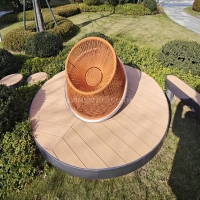Welcome to the website for landscape facilities products and knowledge.
What are the most common regulatory requirements for landscape round trash cans in public spaces?
Landscape round trash cans are essential for maintaining cleanliness in public spaces, but their installation and use are often subject to strict regulatory requirements. These rules ensure functionality, safety, and environmental compliance. Below are the most common regulations:
1. Material Standards: Many municipalities require trash cans to be made of durable, weather-resistant materials like stainless steel, heavy-duty plastic, or coated metal to withstand outdoor conditions and vandalism.
2. Placement Guidelines: Trash cans must be strategically placed to avoid obstructing pedestrian pathways while ensuring easy access. Regulations often specify minimum distances from benches, entrances, and roads.
3. Capacity and Design: Public spaces typically require bins with sufficient capacity (e.g., 30-50 gallons) to reduce overflow. Round designs are preferred for their compact footprint and aesthetic appeal.
4. Lid and Animal Resistance: Lids are often mandatory to prevent litter scattering and deter animals. Some areas require locking mechanisms or weighted bases to resist tipping.
5. Accessibility Compliance: Trash cans must adhere to accessibility laws, such as the ADA in the U.S., ensuring they are reachable for individuals with disabilities.
6. Maintenance and Emptying: Regular servicing is usually mandated, with schedules based on usage intensity. Overflowing bins can result in fines for property managers.
7. Environmental Regulations: Some regions enforce rules on recyclable or compostable liners and separate compartments for waste sorting.
By adhering to these regulations, public spaces can maintain hygiene, aesthetics, and compliance with local laws. Always check with municipal authorities for specific requirements in your area.
Related search:

Recommendation
Swivel chair-Specialty steel structure woven rattan leisure chair with rotatable design